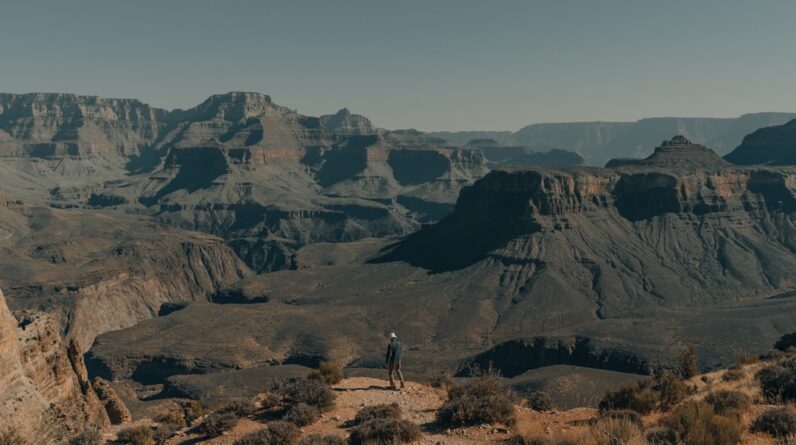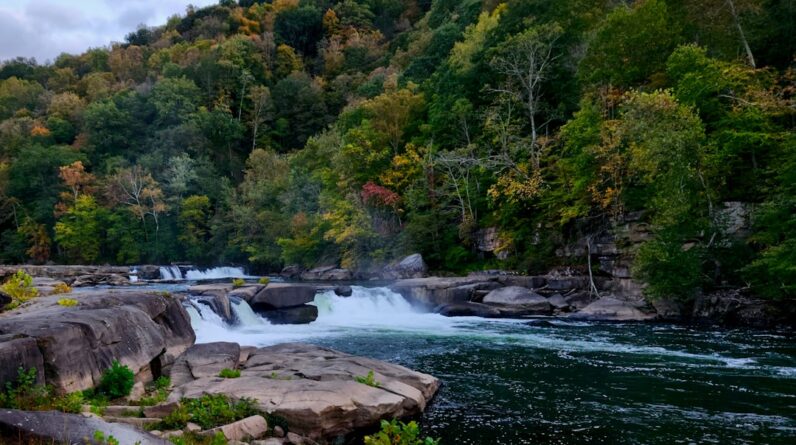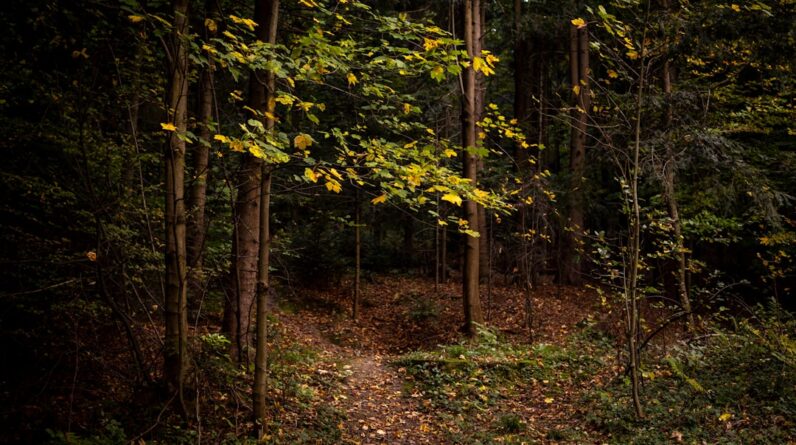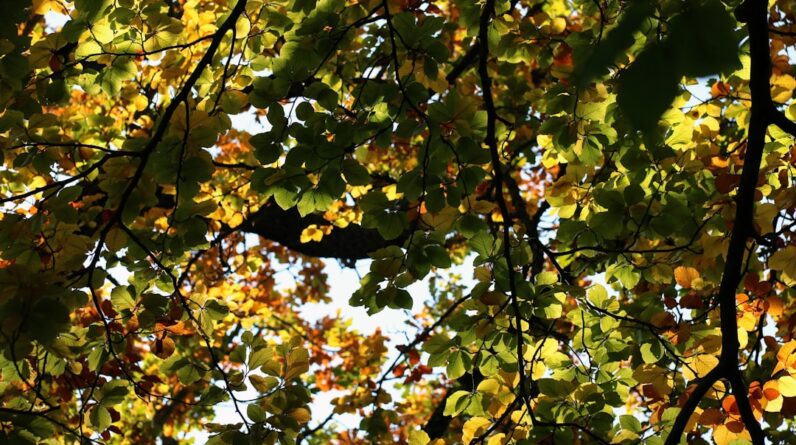The Northern Lights, also known as the Aurora Borealis, are a natural phenomenon that occurs in the polar regions of the Earth. They are caused by the interaction between charged particles from the sun and the Earth’s magnetic field. When these particles collide with atoms and molecules in the Earth’s atmosphere, they emit beautiful colors of light, creating a mesmerizing display in the night sky.
The Northern Lights have captivated people for centuries and hold great significance in different cultures around the world. In Indigenous cultures, they are often seen as spiritual or mystical phenomena, with various legends and stories associated with them. In Scandinavian folklore, they were believed to be the spirits of ancestors dancing in the sky. The Northern Lights have also been a source of inspiration for artists and writers, who have tried to capture their beauty and mystery in their works.
Key Takeaways
- The Northern Lights are a natural phenomenon that occur when charged particles from the sun collide with Earth’s atmosphere.
- Ontario is one of the best places in the world to see the Aurora Borealis, with several provincial parks offering ideal viewing conditions.
- To plan your trip, consider visiting between September and April and bringing warm clothing, a camera, and a tripod.
- Ontario’s provincial parks offer a range of activities for nature lovers, from hiking and camping to wildlife watching and stargazing.
- To capture the magic of the Northern Lights, use a wide-angle lens, a high ISO setting, and a long exposure time.
The Best Places in Ontario to See the Aurora Borealis
Ontario is one of the best places in Canada to witness the Northern Lights. The province offers a variety of locations that provide optimal viewing conditions for this natural spectacle. One of the top locations is Algonquin Provincial Park, which is known for its dark skies and minimal light pollution. This makes it an ideal spot for stargazing and seeing the Northern Lights. Another popular destination is Killarney Provincial Park, located on the northern shore of Georgian Bay. The park’s remote location and lack of light pollution make it a prime spot for viewing the Aurora Borealis.
Pukaskwa National Park is another great location to see the Northern Lights in Ontario. Situated on the shores of Lake Superior, this park offers stunning views of the night sky and is far away from any major cities or towns. Other notable locations include Sleeping Giant Provincial Park, which offers panoramic views of Lake Superior and its dark skies, and Quetico Provincial Park, which is known for its pristine wilderness and excellent stargazing opportunities.
Planning Your Trip: When to Go and What to Bring
The best time to see the Northern Lights in Ontario is during the winter months, from November to March. This is when the nights are longest and darkest, providing optimal conditions for viewing the Aurora Borealis. It is important to check the weather forecast and solar activity before planning your trip, as clear skies and high solar activity increase your chances of seeing the Northern Lights.
When packing for your trip, it is essential to dress warmly, as temperatures can drop significantly during the winter months in Ontario. Layering your clothing is recommended, as it allows you to adjust your attire based on the temperature. It is also important to bring a good pair of insulated boots, gloves, a hat, and a scarf to keep yourself warm. Additionally, don’t forget to bring a tripod for your camera, as it will help stabilize your shots when photographing the Northern Lights.
Exploring Ontario’s Provincial Parks: A Guide for Nature Lovers
Ontario’s Provincial Parks offer a wealth of natural beauty and diverse ecosystems to explore. From rugged coastlines to pristine lakes and dense forests, these parks provide a perfect backdrop for witnessing the Northern Lights. Algonquin Provincial Park is a must-visit destination for nature lovers, with its vast wilderness and abundant wildlife. The park offers numerous hiking trails, canoe routes, and camping opportunities.
Killarney Provincial Park is known for its stunning landscapes, including the iconic white quartzite mountains of the La Cloche Range. The park offers excellent hiking and canoeing opportunities, as well as backcountry camping options. Pukaskwa National Park is a remote and rugged park that offers breathtaking views of Lake Superior and its surrounding wilderness. The park features several hiking trails that take you through diverse landscapes, including forests, rivers, and rocky shorelines.
Sleeping Giant Provincial Park is named after the iconic Sleeping Giant rock formation, which resembles a giant lying on its back. The park offers a variety of outdoor activities, including hiking, camping, and fishing. Quetico Provincial Park is a wilderness paradise, with its pristine lakes, rivers, and forests. The park is a popular destination for canoeing and backcountry camping.
Capturing the Magic: Tips for Photographing the Northern Lights
Photographing the Northern Lights can be a challenging but rewarding experience. To capture stunning photos of the Aurora Borealis, it is important to have the right camera equipment and settings. A DSLR or mirrorless camera with manual controls is recommended, as it allows you to adjust the exposure settings to capture the faint light of the Northern Lights.
When photographing the Northern Lights, it is important to use a tripod to keep your camera steady and avoid blurry shots. A wide-angle lens with a low aperture (f/2.8 or lower) is ideal for capturing the vastness of the night sky and allowing more light into your camera. It is also important to set your camera to manual mode and adjust the ISO, shutter speed, and aperture settings accordingly.
To capture the vibrant colors of the Northern Lights, it is recommended to use a higher ISO setting (between 800 and 3200) to make your camera more sensitive to light. Experiment with different shutter speeds (between 5 and 30 seconds) to find the right balance between capturing enough light and avoiding overexposure. Finally, shoot in RAW format to have more flexibility in post-processing and bring out the details in your photos.
The Science Behind the Aurora: Understanding the Phenomenon
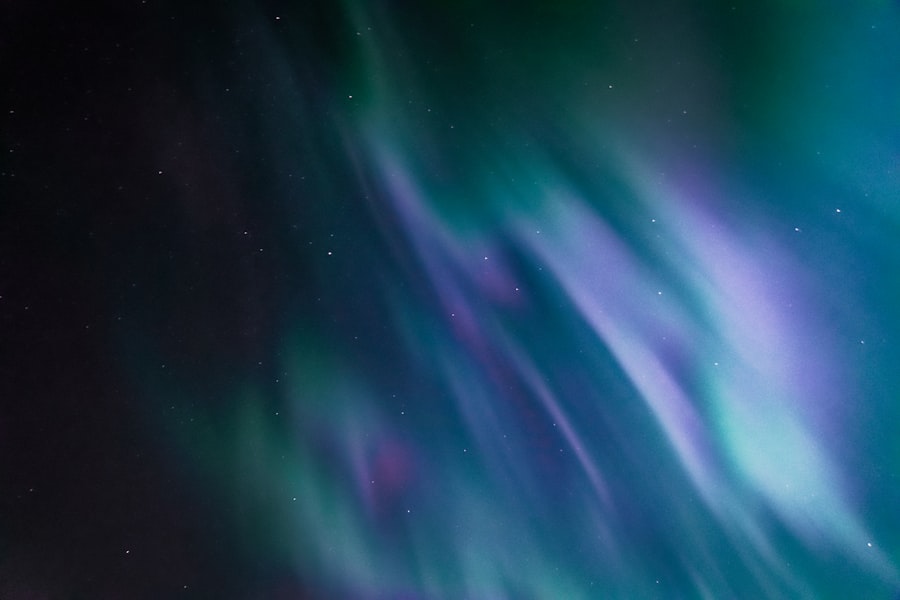
The Northern Lights are a result of solar activity and the Earth’s magnetic field. When there is a high level of solar activity, such as solar flares or coronal mass ejections, charged particles are released from the sun and travel towards the Earth. These particles are mostly electrons and protons, which are accelerated by the Earth’s magnetic field towards the polar regions.
As these charged particles enter the Earth’s atmosphere, they collide with atoms and molecules, particularly oxygen and nitrogen. These collisions excite the atoms and molecules, causing them to emit light of different colors. Oxygen atoms emit green and red light, while nitrogen molecules emit blue and purple light. The colors and patterns of the Northern Lights depend on the altitude at which these collisions occur and the type of atoms and molecules involved.
Solar activity plays a crucial role in the intensity and visibility of the Northern Lights. The sun goes through an 11-year solar cycle, with periods of high solar activity (solar maximum) and low solar activity (solar minimum). During solar maximum, there is an increased number of solar flares and coronal mass ejections, resulting in more frequent and intense displays of the Northern Lights. Solar minimum, on the other hand, is characterized by fewer solar flares and coronal mass ejections, leading to less frequent and less intense displays.
Indigenous Perspectives on the Northern Lights: Cultural Significance and Stories
The Northern Lights hold great cultural significance in Indigenous communities across Canada. They are often seen as spiritual or mystical phenomena, with various legends and stories associated with them. In many Indigenous cultures, the Northern Lights are believed to be the spirits of ancestors dancing in the sky.
In Anishinaabe culture, for example, the Northern Lights are known as “Manidoo Makizin,” which means “Spirit Curtain.” According to Anishinaabe beliefs, the lights are created by Nanabozho, a powerful spirit who uses them to communicate with the living. The lights are said to be a sign of good fortune and protection.
In Inuit culture, the Northern Lights are seen as a manifestation of the spirits of the dead. It is believed that the lights are the souls of the departed playing a game of soccer with a walrus skull. The Inuit also believe that the Northern Lights can be dangerous, as they can snatch away the souls of those who disrespect them.
Beyond the Aurora: Other Natural Wonders to Discover in Ontario’s Parks
While witnessing the Northern Lights is a highlight of any trip to Ontario’s Provincial Parks, there are many other natural wonders to discover in these parks. For example, Algonquin Provincial Park is home to over 2,400 lakes and 1,200 kilometers of rivers and streams, making it a paradise for canoeing and kayaking enthusiasts. The park also offers excellent opportunities for wildlife viewing, with moose, black bears, and beavers being some of the common sightings.
Killarney Provincial Park is known for its stunning landscapes, including the iconic white quartzite mountains of the La Cloche Range. The park offers numerous hiking trails that take you through diverse ecosystems, from forests to wetlands and rocky ridges. The park is also a popular destination for fishing, with its abundant populations of lake trout and smallmouth bass.
Pukaskwa National Park is a remote and rugged park that offers breathtaking views of Lake Superior and its surrounding wilderness. The park features several hiking trails that take you through diverse landscapes, including forests, rivers, and rocky shorelines. It is also home to the Coastal Hiking Trail, a challenging 60-kilometer trail that follows the rugged coastline of Lake Superior.
Sleeping Giant Provincial Park is named after the iconic Sleeping Giant rock formation, which resembles a giant lying on its back. The park offers a variety of outdoor activities, including hiking, camping, and fishing. The park’s extensive trail network allows visitors to explore its diverse ecosystems, from boreal forests to wetlands and rocky cliffs.
Quetico Provincial Park is a wilderness paradise, with its pristine lakes, rivers, and forests. The park is a popular destination for canoeing and backcountry camping, with over 2,000 kilometers of canoe routes and more than 2,000 campsites. Quetico is also home to a wide variety of wildlife, including moose, wolves, and bald eagles.
Supporting Sustainable Tourism: How to Minimize Your Impact on the Environment
When exploring Ontario’s Provincial Parks and witnessing the Northern Lights, it is important to minimize your impact on the environment and practice responsible tourism. Here are some tips to help you do so:
1. Follow Leave No Trace principles: Pack out what you pack in and leave the natural environment as you found it. Dispose of waste properly and respect wildlife and their habitats.
2. Stay on designated trails: Stick to established trails to avoid damaging fragile ecosystems and disturbing wildlife.
3. Respect wildlife: Observe wildlife from a distance and do not feed or approach them. Keep noise levels low to avoid causing stress to animals.
4. Minimize campfire impact: Use designated fire pits and only burn dead wood. Extinguish fires completely before leaving the area.
5. Reduce waste: Bring reusable water bottles, food containers, and utensils to minimize waste generation. Dispose of waste in designated bins or take it with you.
6. Conserve water: Use water sparingly when camping or staying in accommodations. Avoid wasting water by turning off taps when not in use.
7. Support local businesses: Choose locally-owned accommodations, restaurants, and tour operators that prioritize sustainability and support the local economy.
8. Educate yourself: Learn about the local flora, fauna, and cultural history of the area you are visiting. This will enhance your experience and help you appreciate the natural and cultural heritage of the region.
Why Chasing the Northern Lights in Ontario’s Provincial Parks is an Unforgettable Experience.
Witnessing the Northern Lights in Ontario’s Provincial Parks is a truly unforgettable experience. The combination of the mesmerizing Aurora Borealis and the stunning natural beauty of the parks creates a magical atmosphere that is hard to replicate. Whether you are exploring Algonquin Provincial Park, Killarney Provincial Park, Pukaskwa National Park, Sleeping Giant Provincial Park, or Quetico Provincial Park, you are guaranteed to be in awe of the beauty that surrounds you.
In addition to the Northern Lights, these parks offer a wealth of outdoor activities and natural wonders to discover. From hiking and canoeing to wildlife viewing and fishing, there is something for everyone to enjoy. By practicing responsible tourism and minimizing your impact on the environment, you can help preserve these natural treasures for future generations to enjoy.
So, plan your trip to Ontario’s Provincial Parks, pack your camera and warm clothing, and get ready for an adventure of a lifetime. Witnessing the Northern Lights in these beautiful parks will leave you with memories that will last a lifetime.
Check out this related article on defying gravity: the importance of strength training as we age. It discusses the significance of incorporating strength training into our fitness routines as we get older. Maintaining muscle mass and strength becomes increasingly important for overall health and mobility, and this article provides valuable insights and tips on how to stay strong and defy the effects of aging.




